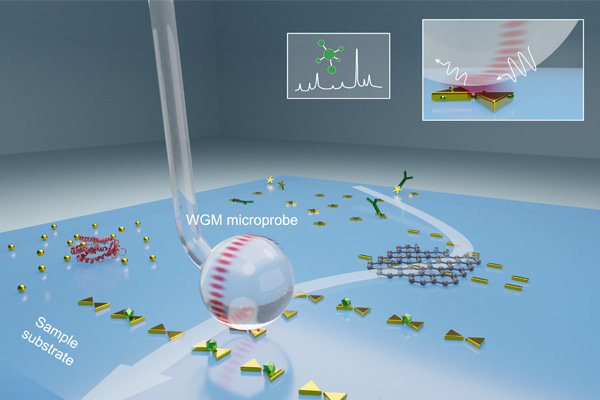Ultrahigh-sensitivity microprobe optimizes detection of molecular fingerprints
A team led by Lan Yang developed a novel whispering-gallery-mode microprobe optimized for ultrahigh sensitivity and increased detection area

Being a good detective requires top-notch evidence gathering, going where the clues are and recognizing their meaning. The same holds true in the realm of sensing technology, where the quest for the perfect balance between ultrahigh sensitivity and a large detection area has been an ongoing challenge. These properties are crucial for a wide range of applications, from biomedical monitoring and chemical imaging to magnetic sensing and vibration detection.
Optical whispering-gallery-mode microsensors, characterized by their ability to trap light in tiny spherical cavities, have emerged as a promising platform for various sensing applications. However, they have historically struggled to achieve both ultrahigh sensitivity and a substantial detection area simultaneously.
Breaking new ground in the field, researchers working with Lan Yang, the Edwin H. & Florence G. Skinner Professor in the McKelvey School of Engineering at Washington University in St. Louis, have developed a scanning whispering-gallery-mode (WGM) microprobe. This novel device represents a shift in the world of microsensors, offering a remarkable solution to the sensitivity-detection area trade-off conundrum. The findings were published Oct. 5 in Light: Science & Applications.
“Akin to placing a contact lens on a tested sample, the WGM microprobe not only focuses light into a smaller spatial spot but also ‘converges’ it in the time domain, trapping light in a microsphere smaller than the diameter of a single strand of hair,” said Wenbo Mao, first author on the paper and a graduate student in Yang’s lab. “This enables light to interact with target molecules thousands of times, greatly boosting the signal.”
“Furthermore, this probe can perform two-dimensional scanning of various samples, enabling hyperspectral imaging containing the unique molecular 'fingerprints' of the target substances,” Mao added.
The key to the novel microprobe's success lies in its fusion of two cutting-edge technologies – whispering-gallery modes and nanoplasmonics.
Whispering-gallery modes work like the famous whispering gallery in St. Paul’s Cathedral in London, where someone on one side of the dome can hear a message spoken to the wall by someone on the other side. Unlike the dome, which has resonances or sweet spots in the audible range, Yang and Mao’s WGM microprobe allows light to circulate around the inside of a microsphere, where it is tuned to cohere and produce an enhanced optical signal.
Meanwhile, nanoplasmonics leverages the behavior of tiny nanoparticles to enhance the interaction between light and matter. By harnessing this unique behavior, scientists can control light to make super-sensitive sensors that can detect incredibly small amounts of substances, even as small as molecules or single atoms.
By combining the advanced capabilities of these technologies, the novel WGM microprobe achieves a sensitivity improvement that is two orders of magnitude greater than that of traditional plasmonics-only enhancement methods. The spherical probe can also be rolled over any surface and scan it to determine a material’s physical and chemical properties, dramatically expanding the probe’s effective detection area.
An important application of this breakthrough is in 2D mapping of Raman spectroscopy with improved resolution and detection limit. Raman spectroscopy is a powerful technique to identify molecular fingerprints, the unique signatures of different materials. The heightened sensitivity of the scanning microprobe enables the detection of molecular signals with unprecedented strength, further enhancing the Raman signal more than 100 times over the enhancement provided by surface-enhanced Raman spectroscopy (SERS).
The improved sensitivity also comes at a lower cost in terms of optical power when compared with conventional SERS. This means that researchers can obtain stronger signals while using less optical power, which has significant implications for the practicality and efficiency of molecular detection in various fields.
“The WGM microprobe establishes a versatile system for ultrahigh-sensitivity sensing with a larger detection area,” Yang said. “With the spatial scanning of samples, the WGM microprobe will become a versatile tool to analyze the physical and chemical properties of materials, including characterization of ultrathin 2D materials with applications in next-generation electronics, detection of pathogenic bacteria on food surfaces, and highly sensitive molecule sensing in blood or serum samples for aiding medical diagnostics.”
Mao W, Li Y, Jiang X, Liu Z, Yang L. A whispering-gallery scanning microprobe for Raman spectroscopy and imaging. 12, Article number: 247, Oct. 5, 2023. Light: Science & Applications. DOI: https://doi.org/10.1038/s41377-023-01276-2
This work was supported by the National Institutes of Health (NIH-1R21EB03084501A1).




